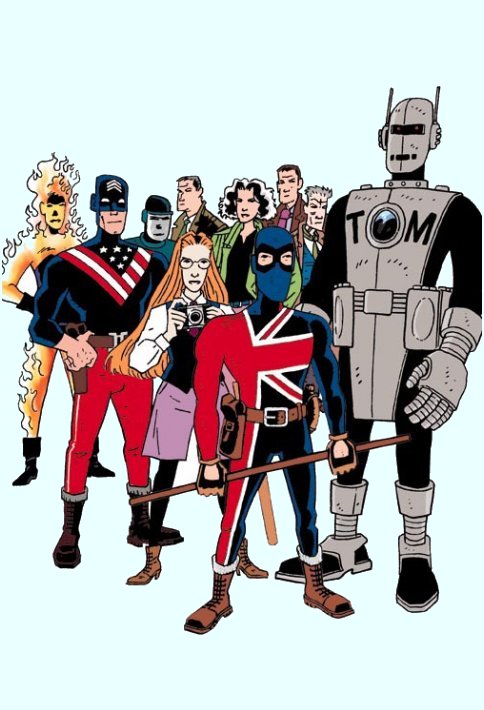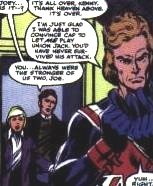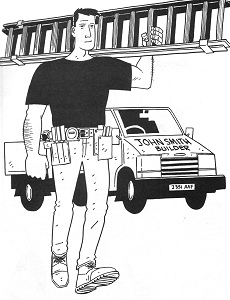
Paul Grist’s Jack Staff is a wonderful comic, but every time I read it I wonder if it’s intended for anyone other than me.
When I say “me”, I actually mean an audience which obviously includes Paul himself, who is clearly having great fun doing this comic, and people of a similar age who read British and American comics heavily during the 70s and early 80s. I’m 36, and I think the bulk of the audience is a bit older. So this is a comic for comics fans in their early forties…
Before I elaborate, I should point out that even if you are unfamiliar with all the comics Jack Staff references, you can still enjoy reading it. It’s funny, action packed, filled with cool bits and shows a terrific mastery of both narrative and graphic techniques. Paul Grist is a darn good cartoonist (which is a much more comfortable sort of beast than a “writer/artist”), and anyone can appreciate his clever layouts, his use of clean lines and heavy shadows to explore and explode the comic language of panels and pages, his elaborate spiraling storytelling which never feels too convulated and his funny and smooth flowing dialogue. Except that you can get all this by reading Kane, his other book (which is contemporary cop drama) instead. What Jack Staff brings to the table is British superhero nostalgia, and I haven’t had this much of it since the crisis on Infinite Earths homage story in Grant Morrison and Steve Yeowell’s Zenith.
According to Grist, Jack Staff originated from a rejected pitch to Marvel comics for the character Union Jack. The first story arc (collected in Everything Used to be Black and White) is based on the classic Union Jack/Baron Blood story from Captain America #253-#254, dated January-February 1981. The original story (written by Roger Stern with art by John Byrne) was one of my favorites, and re-introduced the modern Captain America to his “old” British buddies Union Jack and Spitfire from the Invaders, a WWII super-team (I put old in quotes, because the Invaders comic was being published in the late 70s, I think nearly up until a couple of years before that Captain America story came out – and I think Union Jack and his sister Spitfire were introduced fairly lately in that series).
Anyway, Jack Staff pulls off a clever remix/update of that story, touching on key scenes (Captain America decapitating the vampire with his shield), introduces a WWII super-team, and also gives a great explanation for how Captain America survived unchanged from WWII to the present day.
(Spoiler: He’s also a vampire.)
 Other than that story, Jack Staff mostly borrows Union Jack’s costume and working-class roots (most British superheroes created by Americans, like Marvel’s Captain Britain and the original Union Jack were upper-class ponces; the Stern/Byrne story above added a last twist by making the person who finally puts on the Union Jack suit the working class friend of the original hero’s son, rather than the apparent heir to the mantle). Grist elaborates on this very nicely by making Jack Staff’s secret identity a builder (what we in Hebrew might call a בנאי, but more likely a שיפוצניק – sorry for LJ readers if my Hebrew is scrambled). In a lovely bit of narration, he asks (paraphrasing here) “Builders! Why are they always taking long breaks and where do they disappear to? Maybe it’s because they’re… superheroes?”
Other than that story, Jack Staff mostly borrows Union Jack’s costume and working-class roots (most British superheroes created by Americans, like Marvel’s Captain Britain and the original Union Jack were upper-class ponces; the Stern/Byrne story above added a last twist by making the person who finally puts on the Union Jack suit the working class friend of the original hero’s son, rather than the apparent heir to the mantle). Grist elaborates on this very nicely by making Jack Staff’s secret identity a builder (what we in Hebrew might call a בנאי, but more likely a שיפוצניק – sorry for LJ readers if my Hebrew is scrambled). In a lovely bit of narration, he asks (paraphrasing here) “Builders! Why are they always taking long breaks and where do they disappear to? Maybe it’s because they’re… superheroes?”

So, the first story is based on a comic from 1981; but further issues keep adding characters, building a secret history of British superheroes, mystery men, detectives, mystics, etc, all of them with their roots in old British comics. Captain Hurricane (a WWII Royal Marine strongman, which Grist casts as a British version of the Hulk), Janus Stark (renamed Charlie Raven here), the Steel Claw (he’s got a metal hand that can cause electric shocks, and he turns invisible. He’s a crook, no he’s a secret agent, no a… British superhero. Paul Grist actually makes him all three, at the same time) , the Spider, Adam Eterno…
There are also cameos/spoofs of British comic creators, like the unmistakable “Morlan the Mystic”.
Now, I’m tittering with glee on nearly every page I turn, recognizing characters from ancient British Boy’s Comics that my maternal grandmother used to send me as a kid. But I keep wondering, is anyone else getting this? And how good is this, without the in-jokes, nods and winks?
Pretty good, I think.
2 replies on “Jack Staff”
[…] Comics has put the first issue online as a sample. This article discusses the superhero nostalgia of Jack Staff, identifying the original Marvel story that […]
[…] Jack Staff es algo distinto. Surgió de un proyecto malogrado para Marvel en el que tenía que poner al día un personaje de esos terciarios que aparecen de cuando en cuando por las series de la casa: Union Jack. La propuesta que presentó en “La casa de las ideas” (a finales de los 90) no fue del gusto de los editores y, sin inmutarse lo más mínimo, pegándole un pequeño lavado de cara, se lo autopublicó en Dancing Elephant Press. El resultado fue una maxiserie de 12 números en blanco y negro que todavía no ha llegado hasta nosotros. En ese momento, Image, siempre al acecho de esas series del panorama independiente que pueden satisfacer al lector de superhéroes, se fijó en él y le ofreció la publicación a mayor escala. De ahí surgió el segundo volumen de la serie, ya a todo color, que ahora mismo está publicando en nuestro país Recerca. […]